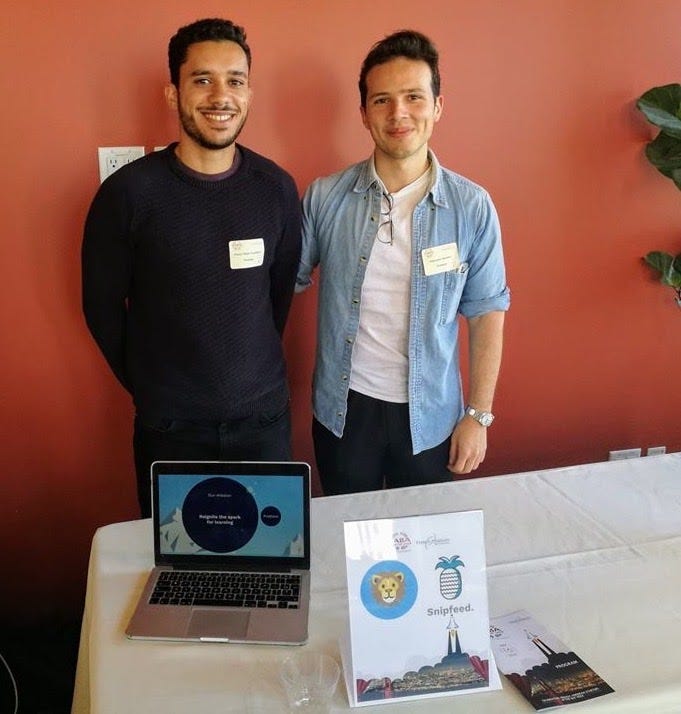On how he went from the classroom to founding the new content creator platform Snipfeed in three years.
Pierre-Habté Nouvellon joined the MEng program in Fall 2017, studying Industrial Engineering & Operations Research. He arrived at UC Berkeley with a very vague idea of what entrepreneurship was, as no one in his family or social circle had taken this path. In fact, entrepreneurship in France was still something abnormal. Yet, Pierre-Habté had a strong desire to learn. Two years later, he is now Chief Technology Officer (CTO) and co-founder at Snipfeed, one of the most promising new content creator platforms. We had the chance to reflect on this journey with Pierre-Habté recently, in light of the upcoming launch of the Snipfeed platform.Looking back, what was the first step in your journey to developing the current iteration of Snipfeed?
“It all started during the MEng bootcamp back in 2017. At that time I had to choose leadership/business related classes to take from the ones proposed by the program. I remember that it was a tough task because all the topics seemed interesting to me, but even more so because all the professors had a very compelling resume. How can you choose between a course given by a serial entrepreneur, a world master in Negotiation Psychology or a top expert on Organizational Behavior? You want to hear from them all! I eventually took the course about entrepreneurship with professor Naeem Zafar, which influenced my future path.
We witnessed the beginning of Jenyai when you were still a MEng student. Now you’re working on a platform for content creators. How did you arrive here?
The initial idea has indeed changed a lot. We have had several pivotal moments since the beginning. They were always driven by some kind of realization and adaptation to reality. The first pivot was switching gears from building an AI tutor to creating a personalized news bot, the first iteration of Snipfeed. We realized that even if students loved Jenyai (we had 5000 users organically), it would take much more research and development to get the product where we wanted to be, and therefore more capital. While AI/education startups were growing exponentially in Asia and well funded, western investors were shy to invest in that field. The turning point was when we got rejected by YC at the final interview. This failed interview with YC was at the end of my time in the MEng program. I remember sitting with Rédouane and Anas, saddened, thinking about what we should do now. On one hand, I had the choice to give up my dream of funding a startup and accept a well-paid job in an established tech company — I was about to lose my OPT visa) — which was the reasonable option to take. On the other hand, I could continue with my startup journey with our amazing team and find a better idea to pursue. I chose option two.

The economic situation has changed a lot in the past three months. How did you react to that?
Remote work is in Snipfeed’s DNA. We had people working remotely from the US, France, and Morocco very early on, and thus were prepared for the stay-at-home policies. In terms of business strategy, we focused our development on the web-platform instead of the app, as we thought people would spend more time on their desktops while at home. In addition, we tailored the platform to not just established content creators, but also to other groups that have seen their businesses shrink with the lockdown and are seeking new ways of generating revenues such as comedians, fitness coaches, yoga teachers, etc.What’s next for Snipfeed?
Our vision for Snipfeed is to become the main place where creators can host their content (videos, podcasts, articles), engage with their fans (through private chats, one-on-one communications, etc.) and monetize in one click through tips, subscriptions, bundles, stream events, premium content and personalized shoutouts. The challenge is huge but we have an amazing team of diverse and talented people working hard to give a voice to content creators!”“I would never have bet three years ago that I would one day be the founder & CTO of a 10 people startup. My journey has just been crazy!” — Pierre-Habté NouvellonPierre-Habté is CTO and head Data Scientist at Snipfeed. He received a MS in Aerospace Engineering from ISAE-SUPAERO in France before getting his MEng degree in Industrial Engineering and Operations Research from UC Berkeley. Connect with Pierre-Habté.
Pierre-Habté Nouvellon, MEng ’18 (IEOR), shares his entrepreneurial journey was originally published in Berkeley Master of Engineering on Medium, where people are continuing the conversation by highlighting and responding to this story.




